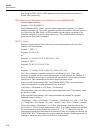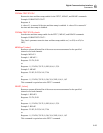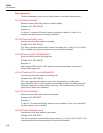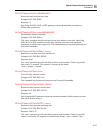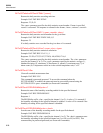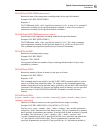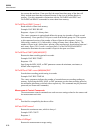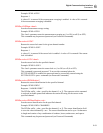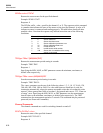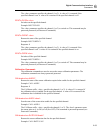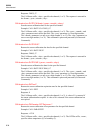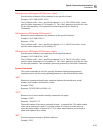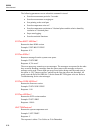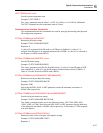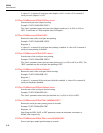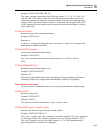
5020A
Users Manual
6-32
SENSor<chn>:STATe?
Returns the sensor status for the specified channel.
Example: SENS1:STAT?
Response: 0
The SENSor suffix, <chn>, specifies the channel (1 or 2). The response to this command
is a number that indicates the state of the sensor on the specified channel. A value of 0
indicates a sensor is connected and reading properly. The table below details all other
possible values. Note that the response may indicate more than one of the following
conditions.
Bit Value Definition
0 1 Sensor not attached
1 2 Sensor read error
2 4 Sensor checksum error
3 8 Sensor calibration parameter error
4 16 Sensor calibration date error
5 32 Invalid sensor ID
6 64 Invalid sensor serial number
7 128 Sensor lock is enabled and the wrong
sensor is connected
TRIGger:TIMer? [MIN|MAX|DEF]
Returns the measurement period setting in seconds.
Example: TRIG:TIM?
Response: 1
Specifying the MIN, MAX, or DEF parameter returns the minimum, maximum, or
default value respectively.
TRIGger:TIMer <num>|MIN|MAX|DEF
Sets the measurement period setting in seconds.
Example: TRIG:TIM 30
The <num> parameter can be one of the following values: 1, 2, 5, 10, 15, 30, 60, 120,
300, 600, 900, 1200, 1800 or 3600. If a value other than one listed here is used, the
instrument automatically selects the nearest acceptable value that is less than the value
entered. Values greater than 3600 or less than 1 are ignored and cause a -222, “Data out
of range” error. Specifying the MIN, MAX, or DEF parameter sets the measurement
interval timer to the minimum, maximum, or default value respectively. The *RST
command sets the measurement period to 2 seconds. This command may be password
protected (see Password Commands).
Channel Commands
The channel commands are used for switching channels on and off.
ROUTe:CLOSe? <chn>
Returns the state of the specified channel.
Example: ROUT:CLOS? 1
Response: 0



